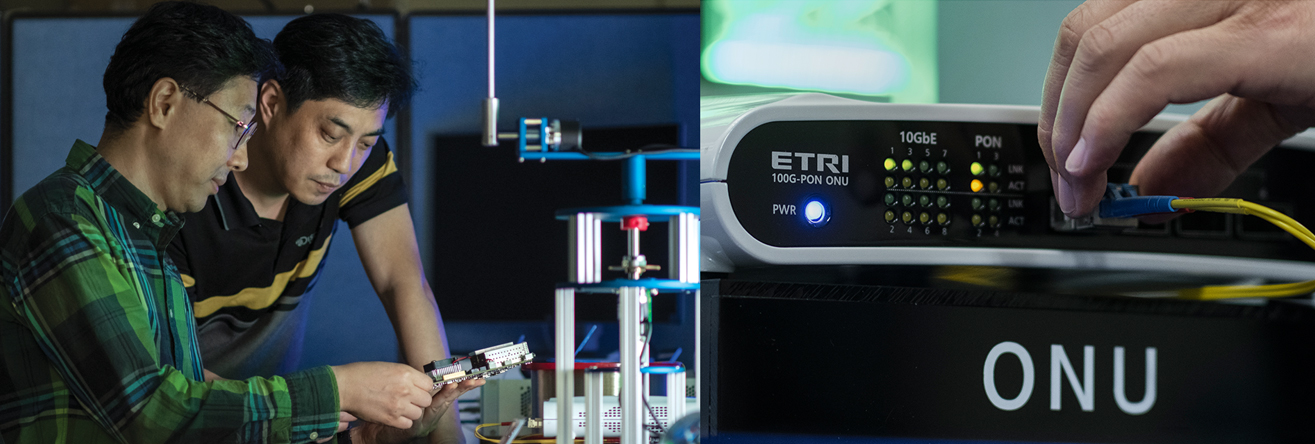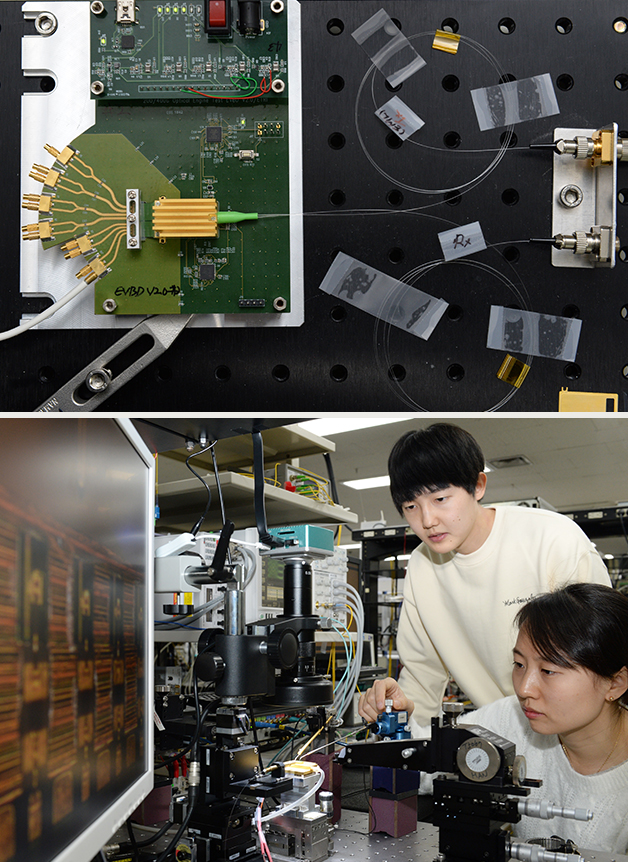
 th Anniversary
th Anniversary
We already send and receive a lot of information on a daily basis such as self-driving cars, real-time telemedicine, Internet of Things (IoT) devices, and Big Data. In the future, an even greater amount of data and information will be generated. How should we prepare for the hyper-realistic society that comes with the spread of new media such as 8K UHD test broadcasting, virtual reality (VR), augmented reality (AR), and holograms? Now is the time when we need to develop core technologies that can facilitate effective use of the rapidly increasing number of wired and wireless data services.

Realization of 0.001 seconds,
within which a human feels a sense of touch
Human ears are capable of distinguishing 1/10 seconds while eyes can distinguish 1/100 seconds, and the human tactile system can feel up to 1/1000 seconds of information delivery. The Internet that can deliver information as fast as the human sensory systems is called the "Tactile Internet."
In order to receive information like we receive information from our hands when devices are connected to Wi-Fi communication through a mobile communication base station, there is a technology that needs to be developed: an optical access technology. It provides wired and wireless services by connecting the distance (20 km or less) between the service provider and the user with optical fibers.
In this regard, finding innovative ways to improve the speed, reduce the delay, power consumption, cost, size, and intellectualization of the optical access network is the prior research task. ETRI has focused its resources on the development of Structured Wireless-Aware Network (SWAN) that integrates wired and wireless access based on software-defined network (SDN).
As a result, ETRI succeeded in developing a core original technology that supports 25 Gbps-grade Internet, which surpasses the maximum speed of the conventional wired Internet (2.5 Gbps) in November 2018. This speed is equivalent to 0.001 seconds of data transmission of the human tactile system, which is evaluated as a technology that has opened the era of the tactile Internet in earnest.
TiC-TOC opens up
the era of the tactile Internet
The Internet up until now had a limit as the speed of connection slowed down when a lot of users were connected to the communication network. This was because it took a long time for a nearby communication station that existed within 20 km from the user to process the traffic. The research team solved this technical issue with the 25 giga-grade tactile Internet technology, and named this technology "TiC-TOC."
ETRI explained that the high-speed optical reception module technology and MAC technology are the core elements of this technology. The high-speed optical reception module is a technology that restores clarity of weak optical input signals. In addition, the MAC technology is a technology that manages packets so that traffic delivered through the optical fiber can be processed with low latency. With these technologies, it is possible to use the existing optical fiber that are used as the Internet line while increasing the speed of the laser operation by 10 times, delivering a large amount of data quickly. In other words, it increases the capacity and speed of the communication network simply by improving the equipment without having to install additional optical fibers.
The research team integrated the optical transmission and reception modules, optical transceiver, and the MAC technology into a single board, and installed it inside the line card. In the future, this technology can be upgraded into the existing Optical Line Terminal (OLT) installed in communication stations, and Optical Network Unit (ONU) installed in apartments or buildings in order to support high-speed, ultra-low latency Internet services.
The research team revealed that this technology was based on the existing technologies of ETRI such as channel bonding technology, low-latency band allocation technology, high-sensitivity optical reception module, and optical transmission and reception technology. Unlike the conventional Internet system had only one channel which was divided among multiple user, resulting in low speed, the improved technology increases the number and speed of channels, enabling a large number of people to use faster Internet without slowing down the speed.


Beyond
400 Gbps ─ the challenge
to develop 1 TB
With the goal of spreading immersive digital life, ETRI is researching and developing technology that supports convenient network access anytime, anywhere. As a result, ETRI has developed the world's smallest optical transceiver, which can transmit 200 G of data per second in the mobile backhaul networks and small metro networks, and the related technologies. This is expected to solve the data bottleneck phenomenon and significantly reduce power consumption and equipment size, hastening the age of hyper-connectivity.
In order to realize the technology, the research team altered the modulation system that changes the intensity of light. Instead of the conventional 2-stage modulation system (NRZ), which sends one bit at a time, the research team adopted the 4-stage high order modulation system (PAM-4) that sends 2 bits at a time in order to dramatically increase the transmission capacity. The research team was able to extend the existing PAM-4 modulation system, which was used only within 1 km of the portal company's data center, to 80 km.
In addition, last March, ETRI used this technology as a basis and successfully developed an optical transmission and reception engine, which is an element technology to achieve the speed of 400 Gbps. When the research team's technology is applied, 100,000 users can stream high-resolution YouTube videos simultaneously. Combined application of the technologies developed by the research team can also improve the issues related to power consumption and cost of communication equipment. In comparison to the existing method, it consumes 1.5 times less power and has 4 times higher density, meaning that the cost of investing in equipment could be drastically reduced.
This technology is a core technology that constitutes the high-speed, high-capacity optical connection. ETRI is expected to become the leader in the age of hyper-realistic Internet, which is connected through light that travels at the speed of terabyte (TB), by developing optical infrastructure technology to deliver high-quality video and ultra-realistic media services.
ETRI is currently making necessary measures to counteract the export restrictions placed by the Japanese government by transferring this technology to Korean optical parts suppliers. ETRI plans to provide necessary support for them to compete with global companies in the data center market. ETRI's research will continue to develop technologies for all the Korean citizens to experience the advanced technology in the nearest future.